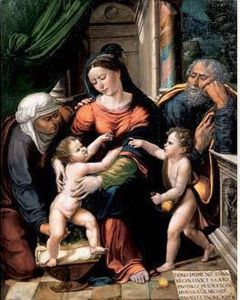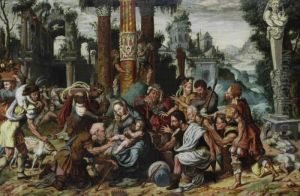Cornelis Ii Buys Paintings
Cornelis II Buys, also known as Cornelis Buys the Younger, was a Dutch painter and architect who lived during the Renaissance period. Born in Alkmaar, Netherlands, around 1495/96, Buys was part of a family of artists that significantly contributed to the Northern Renaissance art movement. His father, Cornelis Buys I (also known as Cornelis Buys the Elder), was a well-known painter, and his brother, Jacob Cornelisz van Oostsanen, was one of the leading Dutch painters of his time. This familial background provided Cornelis II with a fertile artistic environment that nurtured his development as an artist.
Buys' work is characterized by its intricate detail, vibrant colors, and incorporation of religious and mythological themes, which were common among artists of his time. He was primarily known for his contributions to painting and architecture, although specific details about his architectural works are less documented compared to his contributions to painting. His style reflects the transition from the late Gothic to the early Renaissance period in the Netherlands, showcasing both the traditional elements of Dutch art and the new influences coming from Italian Renaissance artists.
Throughout his career, Cornelis II Buys was active in Alkmaar and possibly traveled to other parts of the Netherlands, where he would have been exposed to the works of other Renaissance artists. This exposure might have influenced his artistic development and the evolution of his style. Despite his talent and the quality of his work, Buys did not achieve the same level of fame as some of his contemporaries, such as Hieronymus Bosch or Pieter Bruegel the Elder. This may be due in part to the limited number of his works that have survived or been properly attributed to him.
Cornelis II Buys died in 1545, leaving behind a legacy that, while not as well-known as that of some of his peers, contributes to our understanding of the Northern Renaissance and the artistic transitions of that period. His works are studied by art historians interested in the development of Dutch Renaissance art and the interplay between the late Gothic tradition and the emerging Renaissance style. Despite the challenges in fully reconstructing his oeuvre, Buys remains a figure of interest for those studying the period and the regional variations of Renaissance art across Europe.

